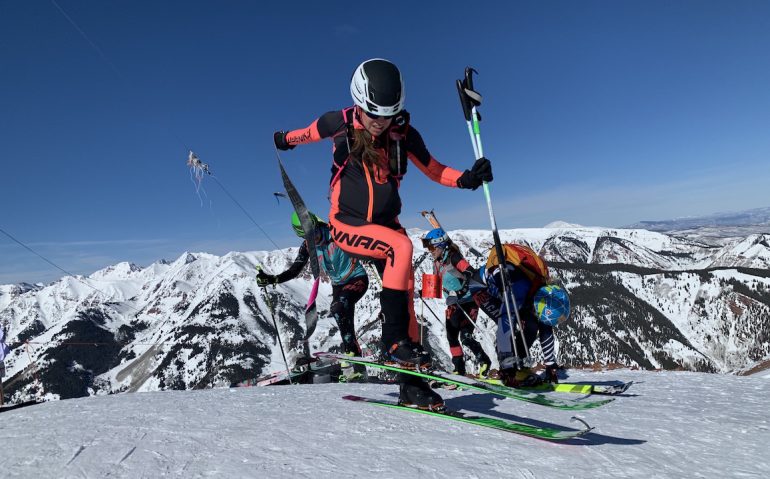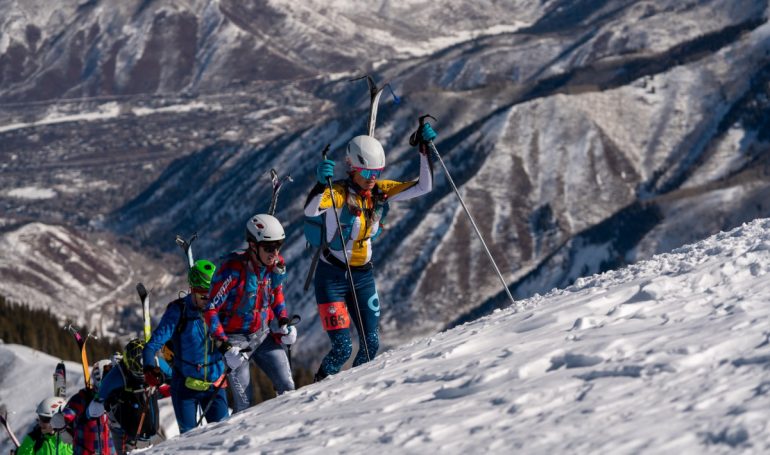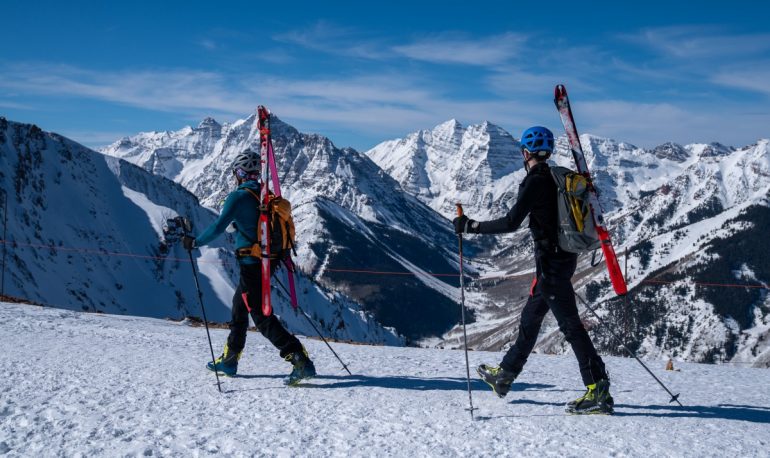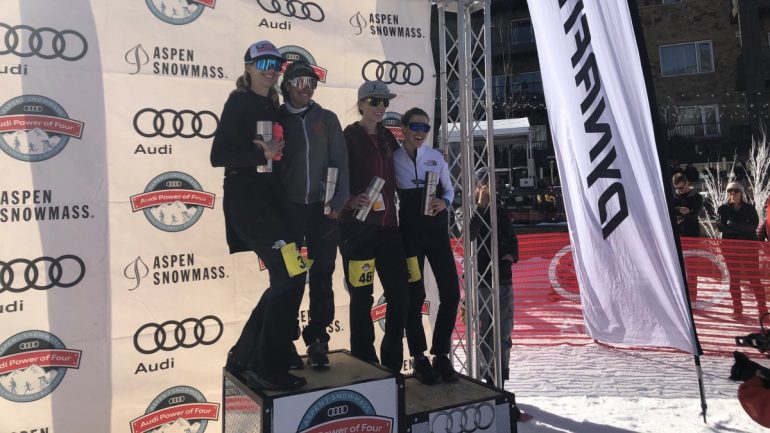Thanks to Cripple Creek Backcountry for sponsoring this post. They love suffering and currently have sales on the gear that’ll make you love it too.

Competition for the ladies USSMA Championship title was fierce, with all three teams reaching the top of Highlands Bowl within minutes of each other. Photo: Joe Risi
The gun cracked, the crowd surged. Still morning air broke with sudden movement — the sound of skins slapping snow, poles shuffling, skiers exhaling. Immediately the corduroy slope steepened. Within minutes, skins began to slip, spandex clad skiers began to flail. Some muscled, others switchbacked, a graceful few stepped lightly, trusting their technique to overcome the forces of mohair on slippery hoar.
My partner, Sarah Hahn and I did a little of everything, trying to not over-assert ourselves so early in the first climb of the Power of Two ski race. The STFU ascent up Aspen Highland’s Thunderbowl ski run offered little warm up and as racers charged and slid around us, we skinned gingerly to resist the momentum of the pack, knowing that a whole lot of race remained. It was both of our first attempts at the “easier” version of the famed Power of Four sufferfest and our basic collective goal was to finish. After writing earlier this winter about being intimidated by skimo races, I’d been putting in my hours on skin track and had my own personal goals to pace well, eat right and maybe get one step closer to figuring out the appeal of this whole skimo racing thing.
While the Power of Two race is an abbreviated version its behemoth bigger brother, it’s by no means a walk in the park. The course covers nearly 17 miles and climbs just shy of 8000 feet up and down Aspen Highlands and Ajax ski areas. The first climb is a burner: 4300 feet from the base of Highlands to the top of Highland’s Bowl. Then down the 40-45 degree bowl, followed by a short skin to the top of a heinous backcountry descent to a final transition and a grueling slog up the 3000 feet over 5.2 mile Midnight Mine Road. Once atop Ajax mountain the race is certainly not over as skiers descend more than 3000 feet of steep bumps on shaky legs and skinny skis. Calling the skiing exciting is an understatement.

Highlands Bowl was the high point of the race (literally, at 12,392 feet) but by no means the hardest part. Photo: Brendan Sandness @brendensandness
Sun and temps in the low 40s offered perfect race weather and we had a healthy pack of 45 teams in the Power of Two (the entire race was sold out with 150 teams total). I was impressed to see a solid showing of heavier touring gear interspersed amongst the feathery race twigs and ultra light boots. My own setup was comprised of Dynafit DNA 153cm skis with Black Diamond Helio 145 bindings, one pair of Contour race skins, one pair Pomoca Race Pro 2.0 skins, Dynafit TLT8 boots and a very fun pair of hot pink and green Euro special carbon Dynafit poles.
Once atop Thunderbowl, the skin track crossed dense forest up Wine Ridge, threaded through sun softened bumps and finally spit us out on the top of Loge Lift. Then it was on to the Highlands Bowl bootpack up to 12,392 feet where the air got thinner but the views grew bigger. The iconic shapes of Pyramid Peak and the Maroon Bells gleamed proudly against the cloudless cobalt sky and it was tough to resist the urge to pause at least a minute to admire.

Pyramid Peak and Maroon Bells provided and distractingly spectacular view on the bowl climb. Photo: Brendan Sandness @brendensandness
With its sustained 40-45 degree pitches, Highland Bowl can feel adventurous on any given day depending on conditions. With 65mm skis underfoot and legs a little wobbly from the long climb, the chalky powder bumps felt particularly exciting, especially with a crowd of rowdy back seating racers plowing down the slope above me. Much as Thunderbowl offered no warmup for skinning, the bowl offered even less of one for skiing. I braced my thighs, let the race skis do the downhill work they were made for and hoped for the best.
Ask veterans of the Power of Four or Two what they dread about the race and you’ll probably hear the words ‘Congo Trail’ and ‘Midnight Mine’. At the bottom of Highlands Bowl, a short skin takes skiers to the top of the aptly named Congo Trail i.e. jungle of despair. The 1.7 mile summer mountainbike route descends a steep, treelined, lugey 1800 feet to Castle Creek Road. It is rarely wide enough to check speed by turning; it is ideal for skiing loose and fast and totally out of control with tree trunks for speed checks. A few skiers make it look good. Most skiers just try to survive it. Sarah and I opted for the steady power wedge, choosing safety over speed. It may not have been fast but it got the job done.
Midnight Mine came next — a final slog that climbs excruciatingly slowly to the top of Aspen Mountain. For over an hour, Sarah and I burrowed into our own heads and doubts as midday sun glared overhead. More than four hours into the race, my mouth had a sickening sugary tang from the chews, waffles and caffeinated goo I’d slurped down. A couple of sips remained in my water bottle. Each bend in the cat tracked road just led to another bend in the road. The few teams in front and behind us seemed to lock into step, choosing the collective rhythm over succumbing to the monotony and slowing down.
There was a bottle of whiskey at the aid station atop Ajax but we opted to throw back cups of water and rip skins instead of taking shots. More double black diamond skiing awaited, all the way to the final groomed pitch to the finish. Plummeting down steep bumps on skinny skis rarely looks good on anyone but the best of skiers. We left looking good to the others and just concentrated on keeping our skis on the snow. What an exhilarating relief it was to finally hit the smooth piste and charge across the finish at Gondola Plaza.
A party was underway and beats thumped through speakers. Pro division Power of Four racers who’d started at 6 a.m. and climbed 11,000 feet over 25 miles milled about in street clothes; some had finished more than three hours earlier. That was the craziest realization of the whole race: despite how challenging it was for Sarah and I to ski up and down two mountains, the pros had skied up and down all four mountains in as fast or faster times.
USSMA Championship winners Max Taam and John Gaston broke their own course record by 9 minutes for a time of 4:28:36 (despite John breaking two poles and borrowing loners from a kind passerby). Super human if you ask me. They were trailed by Tom Goth and Cam Smith (4:38:16) and John Brown and Rory Kelly (5:13:17). Shoutout to WildSnow’s own Doug Stenclik and his partner Davide Gardini who took fourth in the division with 5:46:42.
Ladies vying for the USSMA Championship included Kate Zander and Jill Seager (6:03:24.37), Jessie Young and Nikki LaRochelle (6:10:06.87), and Lindsay Plant and Grace Staberg (6:14:33.58). Talk about cutthroat. Masters Championship top finishers included Timothy Faia and Dirk Friel (6:20:49), Paul Noto and Robert Woerne (6:29:21) and Chris Tuller and John-Mark Pianpiano (7:23:33).
In the non-championship Power of Four races, top placers included Jason Killgore and Logan Greydanus in the men’s race (5:12:06.87), Caroline and Sarah Tory in the women’s race (6:25:03.08), Alvaro Arnal and Kristin Layne (5:56:57.37) co-ed, Nick Ramey and Jamey Kilcoyne (6:30:24) in the Masters. See full results here.
As for the Power of Two, Sarah and I did what we set out to do and more. Our time of 5:45 was fast enough for a second place spot on the podium in the women’s race behind Julie Case and Rachel Beck (5:21:47) and just in front of Kelsey Collins and Clare Zweig (5:55:45). All in all, it was a spectacular day with great skiing conditions, infectious camaraderie and inspiring baddassery.

That official podium will make anyone feel like a winner. Sarah and I on the Power of Two stage (far right). Third place crew MIA.
So, did I get the skimo buzz? Kind of. There is something awesomely infectious about suffering with others among the backdrop of such gorgeous and demanding terrain. I’d definitely do it again. Of course that’s always easier to say after the race is over.
See more race photos on the Aspen Snowmass Facebook page, a full race write-up on the Aspen Times and previous WildSnow Power of Four race coverage.
Manasseh Franklin is a writer, editor and big fan of walking uphill. She has an MFA in creative nonfiction and environment and natural resources from the University of Wyoming and especially enjoys writing about glaciers. Find her other work in Alpinist, Adventure Journal, Rock and Ice, Aspen Sojourner, AFAR, Trail Runner and Western Confluence.
